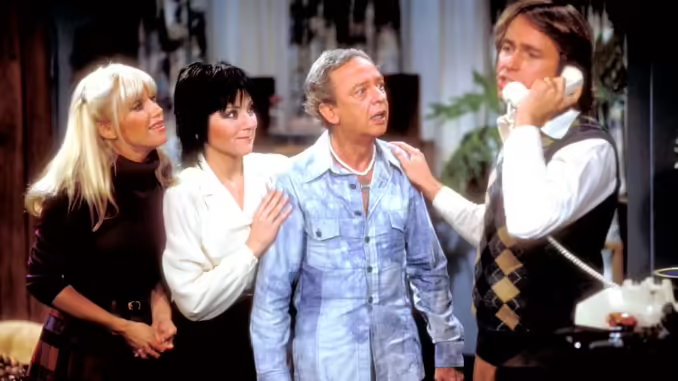
Three’s Company, ABC’s hugely popular sitcom of the late ’70s and early ’80s, earned its place in American pop culture history. For eight seasons, roommates Jack Tripper (John Ritter), Janet Wood (Joyce DeWitt), Chrissy Snow (Suzanne Somers)—and later Cindy Snow (Jenilee Harrison) and Terri Alden (Priscilla Barnes)—invited viewers to “come and knock on our door” each week for a dose of slapstick comedy and innuendo.
But did you know the show launched not one but two spinoffs? Here’s the story of how Three’s Company became Three’s a Crowd—and then ended.

Potential spin-offs for Three’s Company were in the cards from the beginning. The show, which premiered in 1977, was itself based on the successful British sitcom, Man About the House (1973–1976), also about a man with two female roommates. That show resulted in two successful spinoffs for UK audiences: George and Mildred (1976–1977) about their landlords, and Robin’s Nest (1977–1981), which continued the story of Robin Tripp, aka the British Jack Tripper.
American producers perhaps flew a little too close to the sun when they tried to capitalize on the success of Three’s Company early: Instead of waiting until the sitcom had run its course before trying a spinoff, as its British predecessor had, they launched a spinoff titled The Ropers, based on landlords Stanley and Helen Roper (Norman Fell and Audra Lindley), in 1979 while the first show was at its height.
Unfortunately, The Ropers did not take off and only lasted a season and a half, and the two beloved characters could not return to Three’s Company as they had already been written off the show. The upside? The comedic brilliance of Don Knotts as Mr. Furley, who stepped in as landlord on Three’s Company in season four and remained on the show till the end.

In 1980, shortly after The Ropers ended, new trouble was brewing for Three’s Company. When Somers’s contract was up for renewal, she took a stand for equal pay on par with Ritter’s. The ongoing negotiations spilled over into filming for season five, and eventually she was fired. The character of Chrissy was replaced temporarily by her cousin Cindy (Harrison) and permanently by Terri (Barnes).
Now, here’s where TV critics disagree: According to the documentary series The Unknown Story on Peacock, Somers’s exit was the beginning of the end for the show. But Chris Mann, author of 1998’s Come and Knock on Our Door: A Hers and Hers and His Guide to Three’s Company, disagrees.
“The show was completely reinvigorated in Season 6,” Mann told Closer Weekly. “The episode where John did the extended dance sequence on liquor and some sort of tranquilizer is one of the standout episodes of any sitcom. It ranks up there with Lucy stomping grapes or in the chocolate factory.”
By the eighth season, however, Three’s Company ratings were plummeting in the wake of a new show, The A-Team, which premiered in 1983 and became a runaway success. Still, Ritter took home an Emmy and a Golden Globe during that eighth season, and the show garnered the People’s Choice Award. From the producers’ view, a spinoff starring Ritter was the solution.
Three’s Company Becomes a Crowd

Development on Three’s a Crowd, modeled after Britain’s Robin’s Nest, began as the last season of Three’s Company wrapped up. In this second spinoff, Jack Tripper falls in love with stewardess Vicky Bradford (Mary Cadorette) and proposes. Haunted by her divorced parents’ rocky marriage, Vicky refuses. Instead, the unmarried couple moves in together in an apartment above Jack’s restaurant. Her disproving father James (Robert Mandan) buys the building and inserts himself in their lives—and there you have it: three’s no longer company; three’s a crowd.
There was just one problem, neither Ritter nor the producers told the rest of the cast this was happening.

